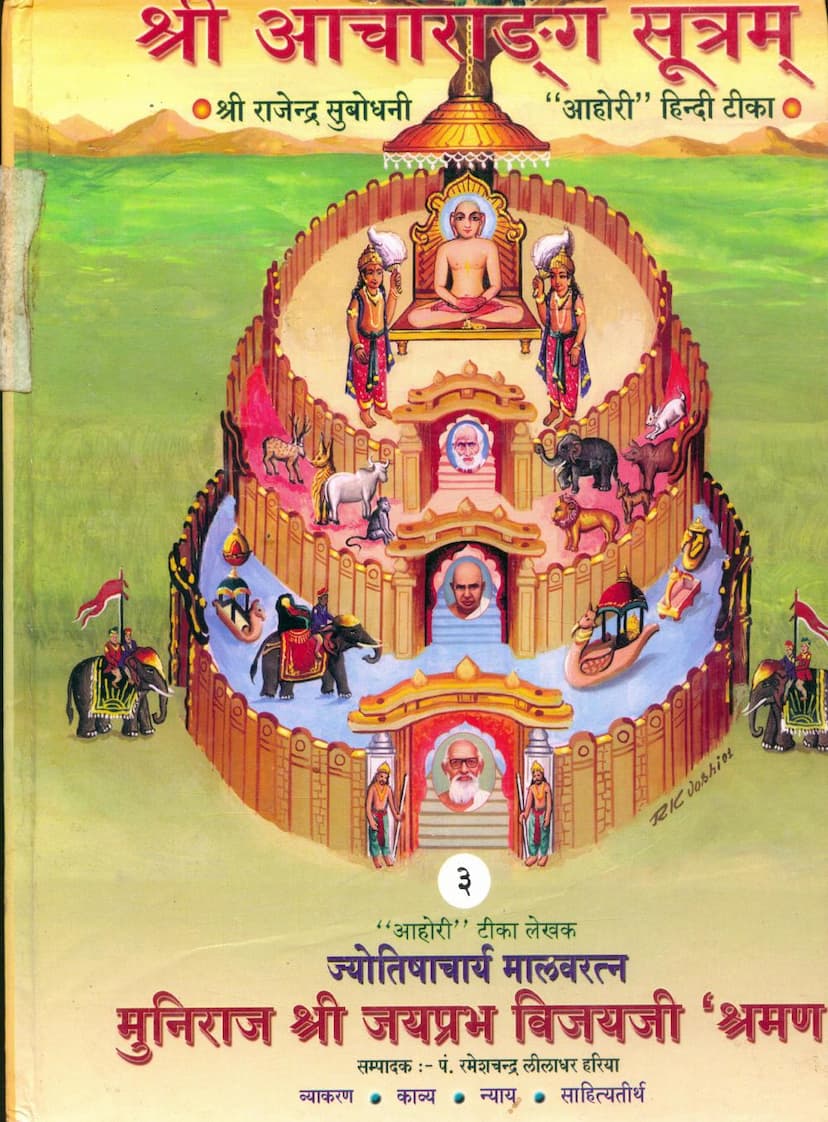Acharang Sutram Part 03
Added to library: September 1, 2025

Summary
Here's a comprehensive summary of the provided text, which is the third part of the Acharanga Sutra with the "Rajendra Subodhini 'Ahori'" Hindi commentary:
Overall Purpose and Context:
This text, "Acharang Sutram Part 03," is a Hindi translation and commentary of the Jain scripture Acharanga Sutra, specifically focusing on the remaining chapters of the first Shrutaskandha. The commentary is titled "Rajendra Subodhini 'Ahori'" and is authored by Muniraj Shri Jayprabhvijayji "Shraman" with editing by Pandit Rameshchandra Liladhar Hariya. The work aims to make the profound teachings of the Acharanga Sutra accessible to modern monks, nuns, and lay followers by providing a clear Hindi explanation of the original Prakrit and Sanskrit texts.
Key Contributors and Publishers:
- Primary Author/Commentator: Jyotishacharya Malratna Muni Shri Jayprabhvijayji "Shraman"
- Editor: Pandit Rameshchandra Liladhar Hariya (Grammar, Poetry, Logic, Literature Acharya)
- Collaborating Editors: Muniraj Shri Hiteshchandra Vijayji "Shreyas" and Muniraj Shri Divyachandra Vijayji "Suman."
- Publisher: Shri Rajendra Yatindra Jainagam Hindi Prakashan
- Key Supporters: Shri Shantilal Vaktavar Malji Mutha from Ahor, Rajasthan, played a crucial role in the publication's financial backing.
Content Covered (Part 3 of the Acharanga Sutra):
This volume specifically covers the following chapters (Adhyayanas) of the First Shrutaskandha, which were likely not included in previous volumes:
- Chapter 6: Dhuta Adhyayana (The Study of Ascetic Practices) - This study delves into various aspects of detachment and the purification of the soul through rigorous practices. It discusses the renunciation of worldly possessions and attachments, the nature of karma, and the importance of equanimity.
- Chapter 7: Mahaparinigraha Adhyayana (The Great Study of Renunciation) - This chapter likely elaborates on the complete renunciation of all worldly things, including even the most basic necessities, and the spiritual benefits derived from such detachment.
- Chapter 8: Vimocha Adhyayana (The Study of Liberation) - This chapter probably focuses on the path to liberation, discussing the cessation of karma and the attainment of the soul's pure and liberated state. It details the importance of proper conduct, knowledge, and faith as prerequisites for liberation.
- Chapter 9: Upadhana Shruta Adhyayana (The Study of Auxiliary Scriptures) - This chapter likely discusses supplementary knowledge and practices that aid in spiritual progress, possibly relating to scriptures or practices that support the main teachings.
Commentary Style and Purpose:
The "Rajendra Subodhini 'Ahori'" commentary aims to provide a detailed and understandable explanation of the original Acharanga Sutra. It includes:
- Original Text: The commentary likely presents the original Sanskrit or Prakrit verses.
- Sanskrit Chhaya: A Sanskrit rendering of the Prakrit verses.
- Bhavanuvada (Essence Translation): A translation that captures the spirit and meaning of the verses.
- Tika-Anuvad (Commentary Translation): A translation of the scholarly commentary, explaining the deeper philosophical and practical implications of the verses.
- Sutrasara (Essence of the Sutras): A summary of the key points discussed in each section.
The commentary emphasizes the importance of "Panchachara" (the five practices: Gyanachara, Darshanachara, Charitrachara, Tapachara, Viryachara) as the means to spiritual purity and liberation. It highlights the teachings of Lord Mahavir Swami and the subsequent elaborations by the Ganadharas and Acharyas like Shilabhadra.
Key Themes and Concepts:
The Acharanga Sutra, as summarized through this commentary, focuses on:
- Conduct and Discipline: The fundamental principles of Jain monastic and lay life, emphasizing strict adherence to vows and ethical conduct.
- Renunciation and Detachment: The importance of relinquishing worldly possessions, desires, and attachments to achieve spiritual freedom.
- Ahimsa (Non-violence): The paramount principle of not harming any living being, applied in thought, word, and deed. This extends to the meticulousness in avoiding harm to even the smallest organisms.
- Tapa (Austerities): The practice of self-discipline and mortification of the body to burn off karma and purify the soul. This includes various forms of fasting and self-restraint.
- Pancha Samiti and Trigupti: The five careful modes of conduct (regarding movement, speech, taking food, handling objects, and excretion) and the three types of control (over mind, speech, and body), essential for monastic discipline.
- Karma and Liberation: The understanding of karma as the force that binds the soul to the cycle of birth and death, and the path of liberation through the eradication of karma.
- Equanimity and Self-Control: The practice of maintaining a balanced state of mind regardless of external circumstances (like comfort or discomfort, praise or criticism).
- Spiritual Purity: The ultimate goal of Jainism, achieved through the purification of the soul from karmic impurities.
Historical Context and Significance:
The commentary itself reflects a tradition of scholarly work dedicated to preserving and propagating Jain Agamas. The preface details the effort behind translating and commenting on these ancient texts for the benefit of modern practitioners. The mention of previous "Vachanas" (recensions or interpretations) of the Acharanga Sutra indicates the text's long history and evolving understanding.
In summary, "Acharang Sutram Part 03" with the "Rajendra Subodhini 'Ahori'" Hindi commentary is a valuable resource for understanding the rigorous ethical and spiritual discipline prescribed in Jainism. It emphasizes the practical application of these principles in daily life and spiritual practice, guided by the teachings of Lord Mahavir and the tradition of Jain Acharyas.